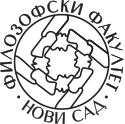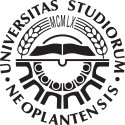15MKMK010 - Old Hungarian Literature 2
| Course specification | ||||
|---|---|---|---|---|
| Course title | Old Hungarian Literature 2 | |||
| Acronym | 15MKMK010 | |||
| Study programme | Hungarian language and literature | |||
| Module | ||||
| Type of study | first degree undergraduate academic studies | |||
| Lecturer (for classes) | ||||
| Lecturer/Associate (for practice) | ||||
| Lecturer/Associate (for OTC) | ||||
| ESPB | 6.0 | Status | ||
| Condition | Oblik uslovljenosti | |||
| The goal | Familiarity with the phenomena and literary processes of the Hungarian Baroque and Late Baroque periods. | |||
| The outcome | Knowledge of the dominant poetic features of the literature of the Hungarian Baroque and Late Baroque periods | |||
| Contents | ||||
| Contents of lectures | Neo-Stoical and Early Baroque elements in the poetry of János Rimay’s and Bálint Balassi’s disciples. The first Hungarian verse novel, a rewriting of Heliodorus’s Aethiopica [Ethiopian Story]: Mihály Czobor's Theagenész és Chariclia [Theagenes and Chariclea]. The genres of Catholic Restoration: sermon, meditative poetry, and school drama. Miklós Zrínyi's epic (Obsidio Szigetiana [The Siege of Sziget]) in the context of the European Ancient and Renaissance great epics. Miklós Zrínyi’s bucolic poetry. István Gyöngyösi’s epic poetry. The poets of the Early Rococo: the Jesuit Ferenc Faludi and László Amade. | |||
| Contents of exercises | The students read and interpret selected poems of Rimay János, excerpts from Mihály Czobor's Theagenész és Chariclia [Theagenes and Chariclea], a number of sermons by Zsigmond Csúzy, Mátyás Hajnal’s Szíves könyvecske [Book of Hearts], a number of descriptions from Pál Esterházy’s Mária-atlasz [The Atlas of Mary], the lyric poems and excerpts from the epic in Miklós Zrínyi's Adriai tengernek Syrenaia [The Siren of the Adriatic Sea], excerpts from István Gyöngyösi’s epic poems (Márssal társalkodó Murányi Vénus [The Venus of Murány United to Mars], Porábul megéledett Phoenix... [The Phoenix that Sprang to New Life from his Ashes…], Csalárd Cupido [The Deceitful Cupid]), and selected poems of Ferenc Faludi and László Amade. | |||
| Literature | ||||
| ||||
| Number of hours per week during the semester/trimester/year | ||||
| Lectures | Exercises | OTC | Study and Research | Other classes |
| 2 | 1 | |||
| Methods of teaching | monological-dialogical method in lectures and discussion, interpretive and interactive methods in practical classes | |||
| Knowledge score (maximum points 100) | ||||
| Pre obligations | Points | Final exam | Points | |
| Activites during lectures | 10 | Test paper | ||
| Practical lessons | 10 | Oral examination | 60 | |
| Projects | ||||
| Colloquia | ||||
| Seminars | 20 | |||

